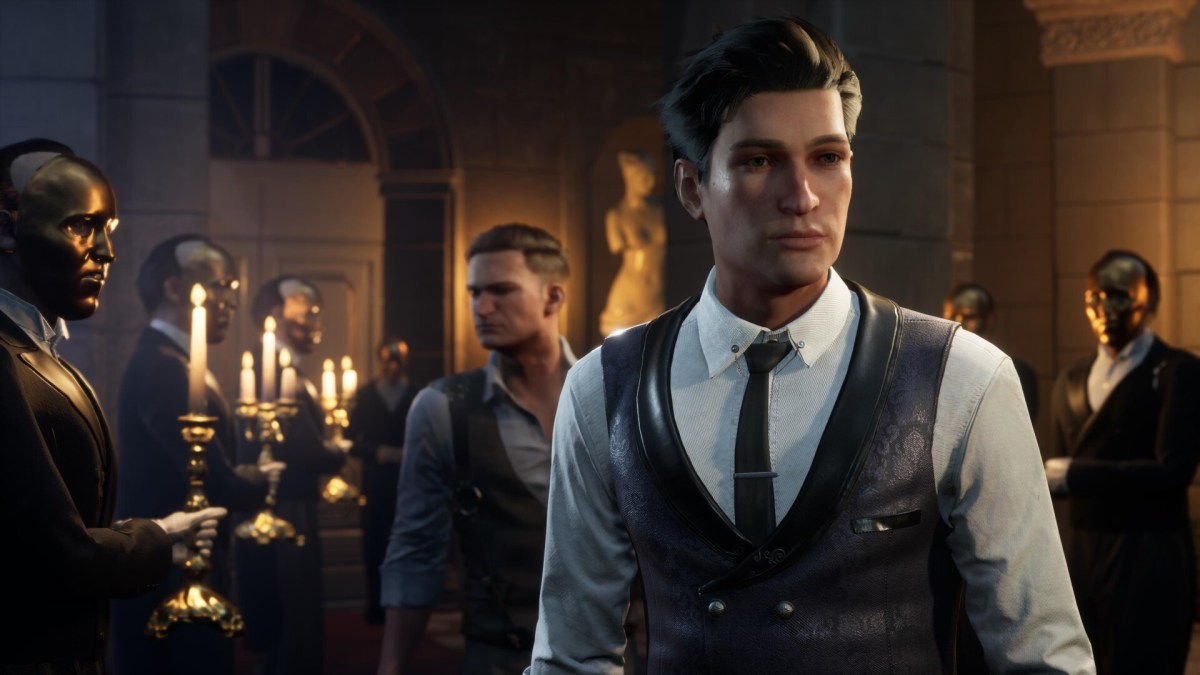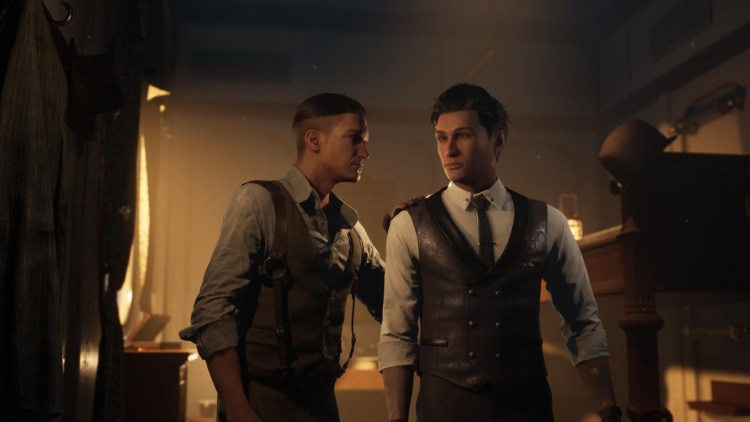Sherlock Holmes Chapter One might seem like an odd title. After all, it’s already the ninth installment in Frogwares’ adventure series starring the famous detective. Still, it’s more than fitting. The game is actually a look at Sherlock’s origin story.
In that regard, it’s apropos that Sherlock Holmes Chapter One is Frogwares’ means of returning to form. However, there were a few minor issues that I experienced while I was reviewing its latest offering. Some were related to combat mechanics, while others focused on the theme of choices and consequences.
Back where it all began
Sherlock Holmes Chapter One sees the titular character as a younger man in 1880. After arriving on the Greek island of Cordona, Holmes soon realizes that this place is far from a paradise on the Mediterranean. Indeed, once you’re done with a fairly short tutorial explaining a few of the game’s mechanics, you’re thrust into a web of conspiracies and deceit.
The narrative arc, though, concerns Holmes’ past. Although he spent his childhood years in Cordona, his mother’s passing caused him to be brought up in Britain. As such, he only remembers fragments of his childhood. Thankfully, he’s assisted by his companion, Jon (aka, not Watson). Jon himself is intriguing. Who is he? What is his connection to Sherlock Holmes? You’ll find some answers soon enough. Along the way, you’ll meet a diverse cast of characters ranging from an eccentric painter with an ulterior motive to a notorious crime boss and his rival envoy.
The game is afoot
As mentioned earlier, Sherlock Holmes Chapter One is part of a long-running franchise. Developer Frogwares is already familiar with the ins and outs, and this offering relies heavily on discovering clues and completing cases once again.
You’ll see a plethora of mechanics here while completing main investigations and sidequests. For instance, there are moments when Sherlock has to find all the clues and evidence in a room. In turn, you’ll talk to witnesses or ask key NPCs for additional input. In other situations, you might need to have evidence on hand while searching through the archives of Cordona’s police station or city hall. Likewise, you might have to determine the origins of a chemical compound or trace a villain’s whereabouts based on an address that’s been provided.
If you progress further in your investigation, you’ll have an opportunity to piece together a crime scene. Let’s say there are four spots in a particular area. You’ll choose what kinds of actions or occurrences ought to be depicted based on the clues you’ve obtained. As this goes on, you’ll also unlock more options in your Mind Palace. If you combine the correct entries, you can come up with a deduction. Subsequently, these help you determine which suspect to accuse. There’s even another decision afterward as to whether the accused should go free or be imprisoned.
All in all, the “whodunit” portions are well structured and highly interesting. I genuinely found myself thoroughly engaged, not realizing how many hours have already passed. Perhaps the only downside is that Jon often disapproves when you make minor mistakes (i.e., choose the wrong option when eavesdropping). It can be a little annoying since the answers aren’t always clear. Still, there are a few related caveats which I’ll discuss later.
Sherlock Holmes Chapter One – Combat, exploration, and performance
The city of Cordona, meanwhile, is somewhat decent. It won’t wow you like the environments seen in big-budget, triple-A titles, but that’s expected. At the very least, you have larger areas that don’t look as drab as the buildings or streets in The Sinking City (also from Frogwares).
It’s not necessarily a true open-world game. It’s more akin to a corridor world with plenty of streets, several fast-travel points, and a handful of interiors. Moreover, at a glance, I was seeing a stable 60 fps at 4K resolution on the highest settings. Granted, I have an Nvidia RTX 3080 and Intel i9-10900K, which are well above the recommended system requirements.
Speaking of interiors, combat tends to take place in abandoned factories or bandit lairs separate from the streets populated by NPCs. One upside is that, unlike The Sinking City, you no longer need to worry about seeing hostiles chasing you across town while NPCs barely bat an eye. The downside is that the combat system, in its entirety, is lackluster. You’ll mostly shoot someone’s armor (on their arms and face), their hat, or a device in the room (i.e., a pipe that blows steam) to stun your opponent. Once stunned, simply walk up to them and press a button to knock them out. It’s simplistic and feels tacked on, which is probably why the feature could be disabled completely.
A master of disguise
One staple of the series is your character’s penchant for using disguises, and Sherlock Holmes Chapter One has plenty of those. From time to time, you’re given hints that you need to wear a different outfit or clothing item just to blend in. Examples include Sherlock trying to look like an Ottoman merchant, a high-born lady, an officer of the law, and a rascal from the streets.
The disguise concepts are decent as is. Still, I’d like to point out how the game attempts to present a narrative where islanders “cling to tradition and eschew outsiders.” It works in terms of the backstory, considering that you’re on a Greek island that was formerly controlled by the Ottoman Empire but is now ruled by the British.
It partly falls flat as a mechanic since all Sherlock has to do is change his clothes to increase his reputation with certain local/cultural groups. Get this value high enough, and you’d fool everyone. You truly have to suspend your disbelief, which is why I’d prefer that Frogwares explore this concept in-depth rather than relying on “wardrobe magic.”
Sherlock Holmes Chapter One – Choices and consequences
Apart from that odd example mentioned above, Sherlock Holmes Chapter One doesn’t shy away from mature themes. Murder victims are found with their throats slit, their limbs twisted, or their bones crushed. Although there’s no nudity involved, one particular mission even leads to a pagan fertility ritual that depicts Cordona’s seedy underbelly (pun very much intended). Moreover, the game also focuses on mental health, with scenes that are emotional and impactful.
Sadly, Sherlock Holmes Chapter One falls flat once we start considering choices and consequences. Remember what I cited earlier regarding the people whom you accuse and the decisions that you make? Well, what if I told you that I completed the campaign and never heard about the important supporting characters ever again? There are still no long-term consequences based on how you concluded each case. It’s acceptable since “there are no right or wrong answers.” However, we’ve already seen what various RPGs and narrative-driven games have done with branching paths and multiple outcomes. Sherlock Holmes Chapter One just lags behind in this category.
In the end, Sherlock Holmes Chapter One still manages to one-up most of its predecessors owing to its investigation mechanics and narrative. The narrative arc is something you don’t want to miss, as it easily has one of the best stories in the entire franchise. It’s just unfortunate that it doesn’t reach its full potential. With all the tools necessary to complete your inquiries and analysis, it becomes too linear and lacks replayability as you progress. It becomes rudimentary, my dear ‘not Watson’.













Published: Nov 15, 2021 12:00 pm